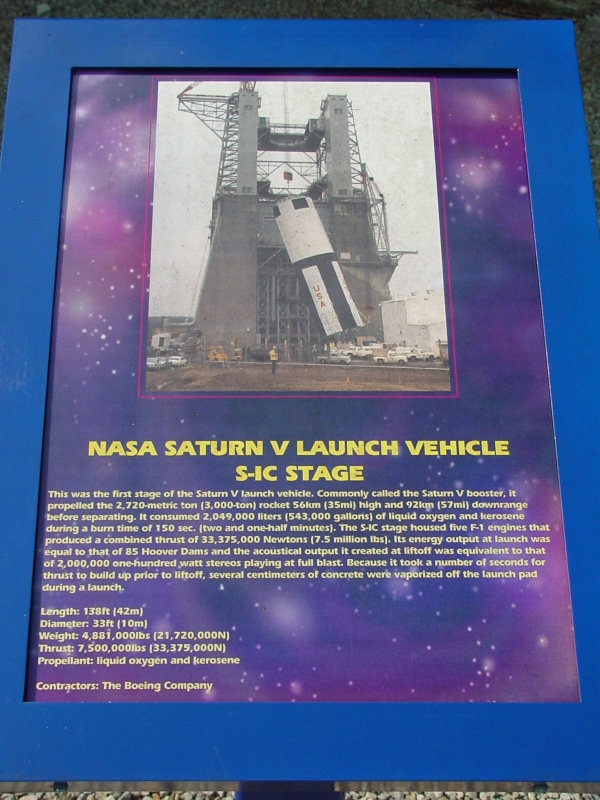| Prev |
heroicrelics.org U.S. Space & Rocket Center Site Index Saturn V S-IC (First) Stage (Rocket Park) Gallery |
Next |
dsc00254.jpg
The sign which accompanied the stage when it was located in the Rocket Park. It reads
NASA Saturn V Launch Vehicle
S-IC StageThis was the first stage of the Saturn V launch vehicle. Commonly called the Saturn V booster, it propelled the 2,720 metric ton (3,000 ton) rocket 56 km (35 mi) high and 92 km (57 mi) downrange before separating. It consumed 2,049,000 liters (543,000 gallons) of liquid oxygen and kerosene during a burn time of 150 sec. (two and one-half minutes). The S-IC stage housed five F-1 engines that produced a combined thrust of 33,375,000 Newtons (7.5 million lbs). Its energy output at launch was equal to that of 85 Hoover Dams and the acoustical output it created at liftoff was equivalent to that of 2,000,000 one-hundred watt stereos playing at full blast. Because it took a number of seconds for thrust to build up prior to liftoff, several centimeters of concrete were vaporized off the launch pad during a launch.
Length: 138 ft (42 m)
Diameter: 33 ft (10 m)
Weight: 4,881,000 lbs (21,720,000 N)
Thrust: 7,500,000 lbs (33,375,000 N)
Propellant: liquid oxygen and keroseneContractors: The Boeing Company
Of course, the "pound" is the Imperial measurement both for mass (lbm) and force (lbf) while the kilogram (kg) is the metric unit of mass and the newton (N) is the metric unit for force. So, while it's appropriate to convert pounds-force to newtons for thrust, the appropriate conversion for 4,881,000 pounds-mass would be 2,213,984 kg.
The photo on the sign shows the stage being loaded into Marshall's S-IC test stand. The S-IC static test stage (S-IC-T) and the first three flight stages were static-fired in this stand. Later stages were test-fired at the Mississippi Test Facility, later renamed to Stennis Space Center.

| Time picture taken | Sat Jul 27 09:46:54 2002 |
| Location picture taken |
Rocket Park U.S. Space & Rocket Center Huntsville, AL |
| Prev |
heroicrelics.org U.S. Space & Rocket Center Site Index Saturn V S-IC (First) Stage (Rocket Park) Gallery |
Next |